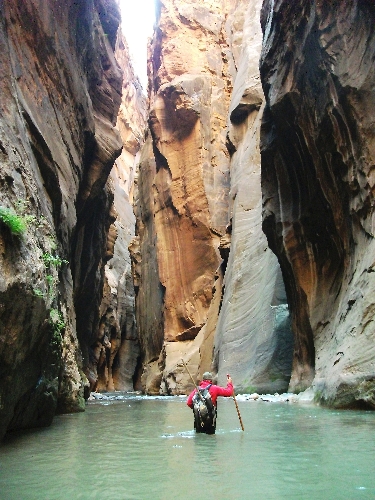Be prepare to get your feet wet while hiking the Zion Narrows

If you have ever aspired to hike the world-famous Zion Narrows, over the next month or so is an ideal time to do so. Water and air temperatures remain as pleasant as they’ll ever be, and the threat of flash flooding is lower than the last couple of months.
The Narrows are located in the North Fork of the Virgin River in Zion National Park, Utah. This hike will test you physically, as the river serves as your trail. The water is cold with swift currents, and the rocks are very slippery, but the rewards are great. You will be hiking within a canyon where, in some areas, its walls rise more than 1,000 feet yet are only 20 feet apart. Along the way, you will also be treated to cascading waterfalls, hanging gardens and hidden alcoves.
There are three ways to hike the Narrows: an out-and-back hike from the lower end; a single-day-through hike from the upper end; or an overnight hike from the upper end, camping in the canyon. The last two require a backcountry permit. If it’s your first adventure in the Narrows, I would recommend the day hike from the lower end to literally get your feet wet. If you have the stamina, you can hike as far as Big Springs — about eight miles round trip and the farthest the park service allows without a permit.
To start your bottom-up hike you take the free shuttle from the Zion Visitor Center up Zion Canyon to the last stop, Temple of Sinawava. Hike up the one-mile paved Riverside Walk. Then you just drop into the North Fork of the Virgin River and head upstream.
Once you are in the river, you will have to make many stream crossings to avoid the deep pools of water and boulders. The best equipment you can have is a wooden staff to use as a third leg; lightweight commercial hiking poles aren’t sturdy enough. If you don’t rent gear from one of the outfitters in Springdale, be sure to head to a home improvement center or hardware store and buy a wooden dowel about 1 to 1½ inches thick and about 5½ feet long, depending on your height and weight.
The greatest danger when hiking the Narrows is flash flooding. Always get a weather report and water flow rate from the Backcountry Desk at the Zion Visitor Center before setting out. It is open this time of year from 7 a.m. to 6 p.m.
The river’s water volume is measured in CFS (cubic feet per second). When it flows at a rate of 120 CFS or higher, back country permits are not issued for through hikes, and when the flow is over 140 CFS, they do not allow hiking from the bottom up. When the water flows less than 70 CFS, you will find the best hiking conditions.
It is cold and wet in the canyon even at this time of year. Wear warm synthetic clothing such as fleece — no cotton. Either line your pack with a heavy garbage bag or put your gear in a dry bag. Canyoneering shoes, neoprene socks and a wooden walking staff are strongly recommended for this trip and are available to rent as a package from Zion Adventure Company or Zion Rock and Mountain Guides for $19 a day. Both companies are in Springdale, near the entrance to the park.
Deborah Wall is the author of "Great Hikes, A Cerca Country Guide" and "Base Camp Las Vegas: Hiking the Southwestern States," published by Stephens Press. She can be reached at deborabus@aol.com.












